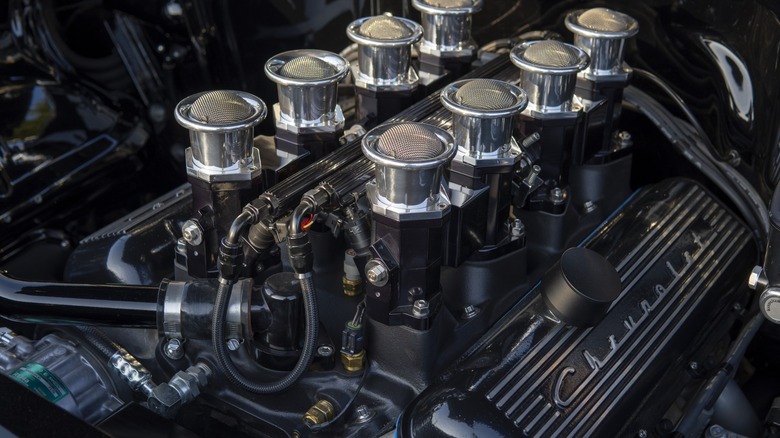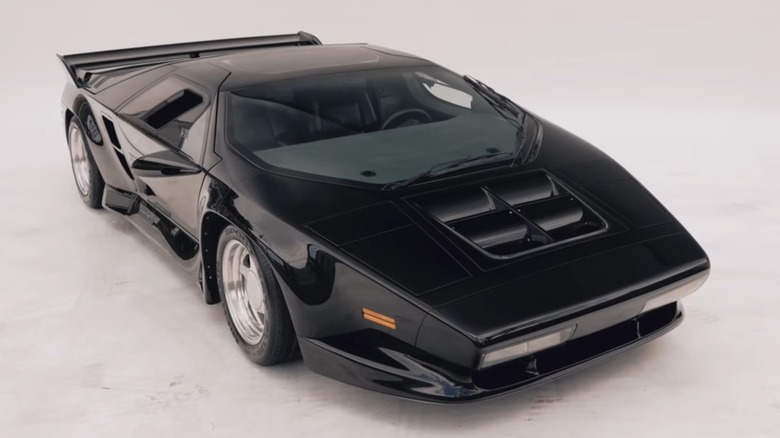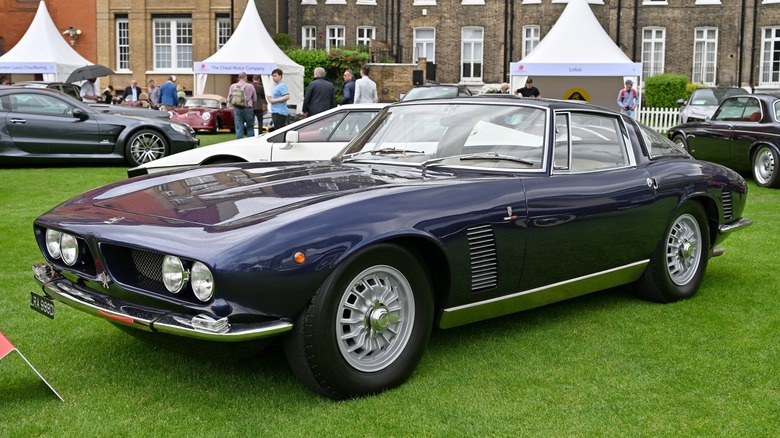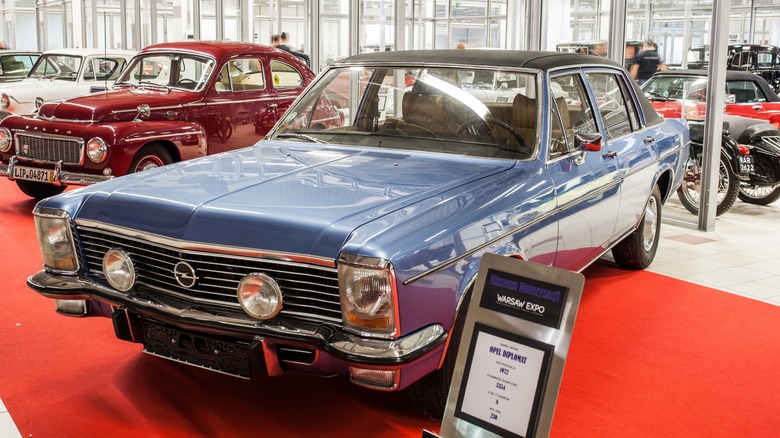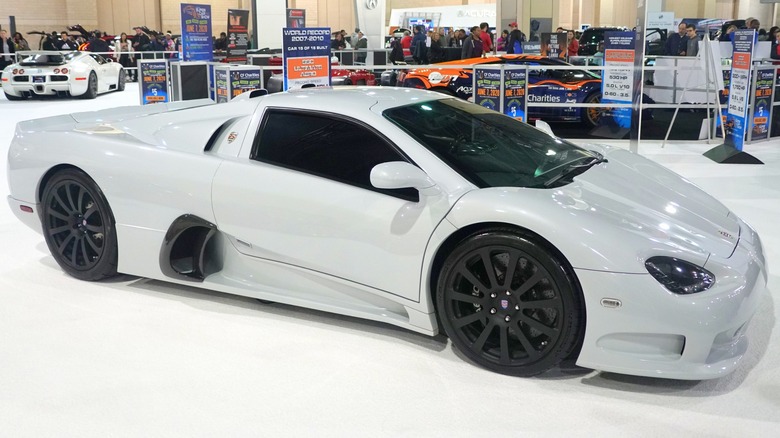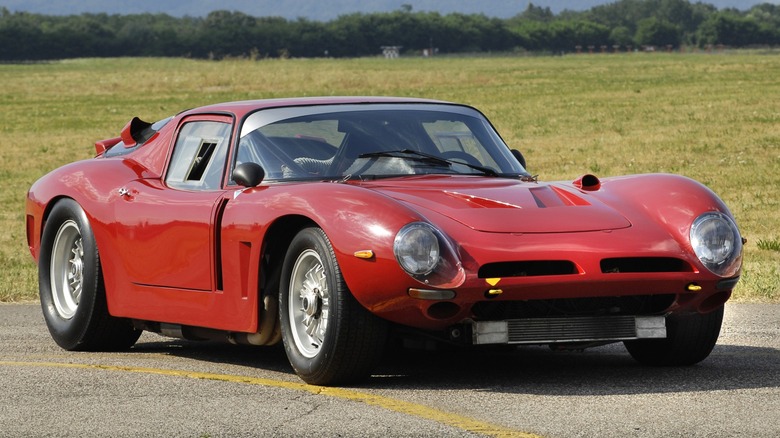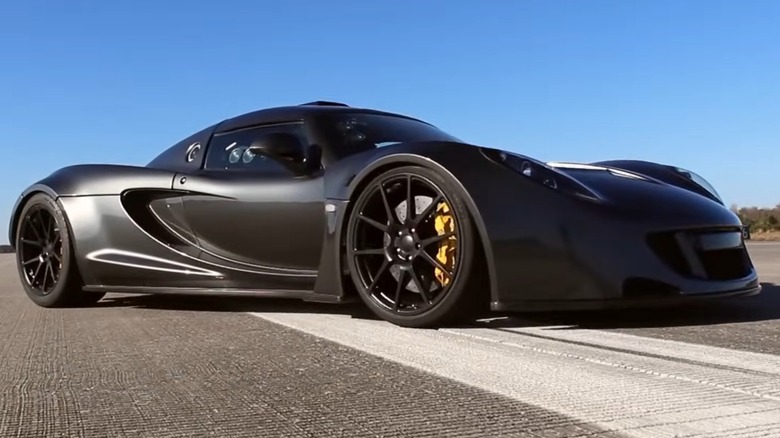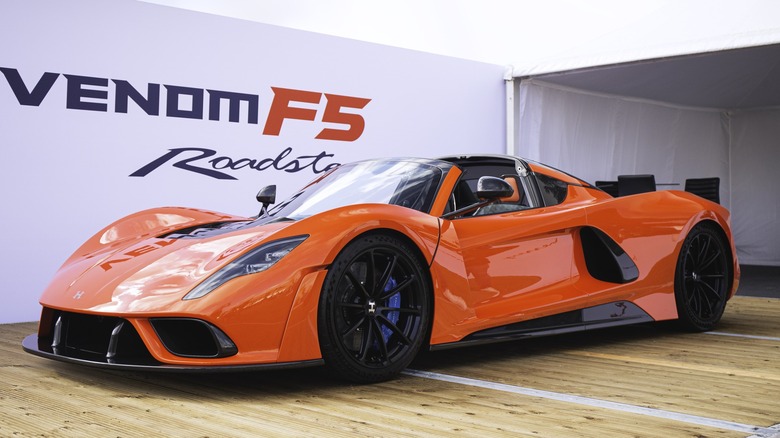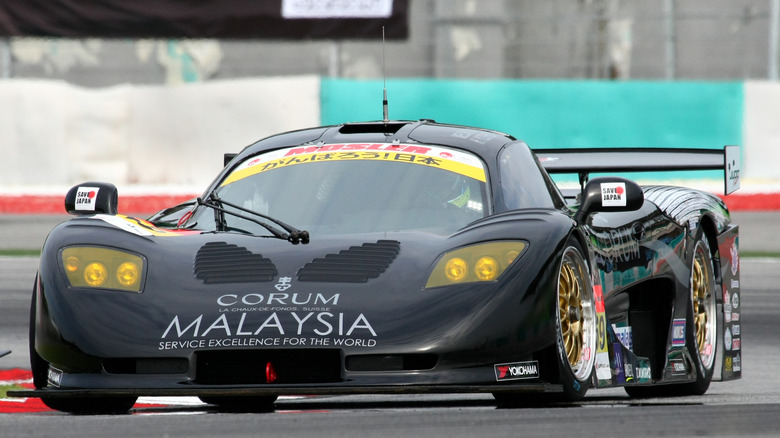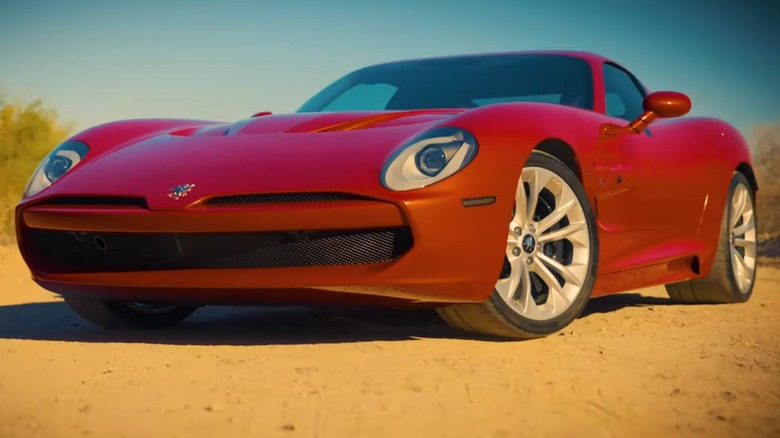10 Non-Chevrolet Cars Powered By Chevy V8 Engines
Since 1955, the entry-level division of General Motors has been producing cars powered by a low-cost and reliable V8. Available in a range of sizes, the small-block Chevy gained legendary status thanks to the 327 and 350 versions starting in the '60s. Furthermore, while it is an engine that can be made to produce extreme power levels, manufacturing is also affordable enough that it can be widely used for ordinary passenger cars and light trucks.
Chevrolet has continued this tradition with successive engine designs up to the modern day. This made the small-block Chevy V8 and its successors ubiquitous in their many forms throughout North America and beyond. However, less ubiquitous are cars powered by a Chevy V8 that do not wear the iconic Bowtie emblem on the grille.
For small automakers, developing an engine represents an enormous investment, especially when that engine will be built in limited numbers. To prevent your bespoke luxury sports car from commanding a price that even the ultrawealthy would call extreme, sourcing components from established manufacturers can be a sound business decision. Others just want to build a car, and sourcing an acceptable drivetrain from elsewhere can get the job done. Chevrolet has a long history of supplying parts and components to other automakers, and the 10 cars listed here all come with bona fide helping of American V8 power.
Vector W8
Since the emergence of the iconic Lamborghini Miura in 1966, the mid-engine supercar has been associated with Italian car manufacturers. While it remains home to two of the most prominent supercar manufacturers, a few Americans have taken a shot at the Raging Bull and Prancing Horse over the years. Just a few years after Ferruccio Lamborghini released the mid-engine Miura, Gerald Wiegert of Los Angeles founded Vector Aeromotive Corporation to design and build an American competitor.
Work began in 1972 with prototypes soon following, including the 1978 W2. Although the W2 received multiple reviews from the automotive press and covered 100,000 miles, production did not commence until 1990. When a production car did come to fruition, it arrived in a futuristic composite and fiberglass hull and was now called the W8. Inside, drivers were greeted by more futurism from a digital display monitoring various aspects of the car and a bevy of dashboard buttons that look like they were borrowed from an F-15 Eagle. Nonetheless, it was stunning.
To match its appearance, Wiegart installed a 6.0-liter engine lifted from the Chevrolet Corvette but with dual turbochargers added for a total output of 625 horsepower. The Vector W8 had the looks and the power needed to be the ultimate American supercar, but unfortunately, Vector Aeromotive Corporation lacked funds. Sadly, Vector folded after only 17 of the very expensive cars were built as Lamborghini owner MegaTech bought the company.
Iso Grifo
In the 1950s, Italian company Iso produced motorcycles and created the tiny Isetta. As the 1960s arrived, Iso enlisted Giotto Bizzarrini, designer of the Ferrari GTO chassis, to create a new grand touring car with Bertone designer Giorgio Giugiaro handling its styling.
Called Grifo, the new car debuted in 1962 at the Turin motor show and went on sale in 1965. The new car, built by Bertone, compared favorably to anything else coming from Italy at the time, with svelte styling on the exterior matched by an upscale and stylish interior featuring luxury appointments and details such as fine leather upholstery.
To match its power output to the styling, Iso opted for a 327 V8 from the Chevrolet Corvette, ensuring it would have plenty of power to compete with contemporary Ferrari and Maserati GT cars, but with typical Chevy reliability. The 327 featured high compression heads and was tuned to produce 350 horsepower going to the wheels through a De Dion rear axle with stopping provided by four-wheel disc brakes. Although much more expensive than a Corvette, the Grifo weighed less while being more refined. Ultimately, only 412 examples of the 327 V8 Grifos — alongside another 70 Chevrolet big-block 427 V8 units — were built before Iso went under in 1973.
Opel Diplomat
Several European boutique automakers opted for Chevrolet power for their bespoke cars, and the European division of General Motors once did the same for its largest luxury offering for the time.
While it is now under the Stellantis umbrella, Opel was a division of GM for decades. Its cars fit within the European market much like Chevrolet does in North America, except it was a bit more wide-ranging. That meant Opel produced subcompact cars for those on a budget as well as large upscale cars catering to luxury buyers, with the Diplomat at the top of the range. When introduced, the Diplomat was meant to lure in buyers of Mercedes-Benz vehicles by offering a large car –- by European standards –- with luxury interior appointments and ample power on tap.
The exterior and interior design of the car achieved the desire for an upscale appearance while a Chevrolet small-block V8 provided the power. Initially equipped with an under-powered 283 small-block V8, engines started to show signs of premature wear, prompting GM to direct Opel to install a high-performance 327 in 1966. Although it was aimed at Mercedes buyers, the Diplomat failed to lure many into the showroom, and Opel ended production in 1977.
SSC Ultimate Aero
The company known as SSC started its life as Shelby SuperCars, named for founder Jerod Shelby. However, to avoid confusion with cars created by automotive legend Carroll Shelby, it was shortened to simply SSC. Long before the need to clear up any naming confusion, SSC started building what would become the fastest production car in the world, the SSC Ultimate Aero.
After many years of development, the Ultimate Aero entered production in 2006. This was the culmination of years of work by Shelby, an accomplished mechanical engineer long before starting the automaker. The car was developed under Shelby's philosophy of building the perfect car and having it ready for production before introducing it to the public. Little fanfare accompanied the process, and years of meticulous testing went into its development, including trials at NASA's wind tunnels.
To build the most powerful car possible, Shelby opted to use existing technology as a base to which he could modify, add to, and improve upon for the desired outcome. For his first car, the base was a Chevrolet V8. Early prototypes used a twin-turbo Corvette V8 while later models used supercharging. With that supercharged Chevy V8, the SSC Ultimate Aero managed to best the Veyron and take the title of fastest production car at 256.14 mph in 2007. That's the kind of accomplishment to make the home team proud, even if only 25 examples of these wicked supercars were ever made.
Bizzarrini 5300 GT
Shortly after developing the timeless and now priceless Ferrari GTO, Giotto Bizzarrini embarked found him designing a V12 for Ferruccio Lamborghini and later creating cars for boutique automaker Iso. The Iso project went along for several years until Bizzarrini had some kind of falling out with Iso resulting in him taking his Iso design and using it to build his own car.
Dubbed the Bizzarrini 5300 GT, the new car featured beautiful Italian styling with an engine up front but behind the front axle, making it a front mid-engine car that offered perfect weight distribution. Although it shared a chassis with the Iso, its bodywork was unique. However, it did share the same Chevrolet 327 V8, providing ample power from a robust and reliable package.
Built in both Strada and Corsa versions for the street and the track, the incredibly low-slung and road-hugging car was capable of hitting nearly 200 mph thanks to its 327 V8 pushing out power in the range of 350 to 420 horsepower. Production of these gorgeous automobiles ended with fewer than 100 copies built. Today, they are rare and extremely sought after –- one sold by Sotheby's in 2023 brought in a winning bid of $915,250.
Hennessey Venom GT
Back in 1991 and starting with his own Mitsubishi 3000GT VR4, John Hennessey launched a career and business modifying and tuning cars with incredible results. Work on custom modifications for Mitsubishis led to a wider array of work on cars such as the Dodge Viper as Hennessey began making a name for himself and his company. Once well established as the place to go for extreme horsepower, Hennessey began building its own car.
Starting with a chassis from Lotus, Hennessey created its own car set to break speed records. Since the Lotus was built for a four-cylinder engine, Hennessey had to make extensive changes to handle the girth of a V8 along with the added stresses from the power. In the end, the chassis was radically transformed into the Hennessey Venom GT, an American built hypercar with more than 1,200 horsepower.
The incredible output comes courtesy of a 7.0-liter Chevrolet LS7 V8 fed air and fuel by twin-turbochargers. Eschewing a sophisticated high-revving DOHC V12 to build power, Hennessey chose brute force from a traditional American pushrod block of sufficient size to accomplish its goal. With that brute force, the Venom GT was certified as the fastest production car in 2014 with a top speed of 270.49 mph.
Hennessey Venom F5
Hennessey's Venom GT was a new standard for American hypercars that set a speed record in the process. However, that car was a combined effort with an English company providing the chassis and the final car production happening overseas with engines built in Texas. For the Venom GT's successor, it would be a wholly domestic affair.
The second car from the Texas-based company was designed from the ground up with original plans. Holding the car together is a 190 pound carbon fiber chassis built to be extremely light and strong while maintaining enough rigidity to keep the wheels in the right direction. The rest of the engine and suspension components are also optimized for weight savings, using lightweight alloys where possible. The ball bearings of the turbos are made of 3D printed titanium for the optimum blend of strength and weight. However, this precision engineering and bespoke manufacturing is pricey -– the Venom F5, of which only 24 will be made -– costs $1.8 million before options.
To push the Venom F5 past 300 mph, Hennessey has installed a twin-turbo pushrod V8 using a Chevy V8 as its base. However, that engine — which is called Fury — is also so heavily modified that it departs from what you might find in a Corvette in many ways.
Laforza
The SUV is overwhelmingly popular on American roads, although you see plenty of them in Europe and elsewhere. Small hatchbacks used to be big sellers overseas, although SUVs have largely replaced them today. Until recently, the only older Italian SUV you might be familiar with is the Lamborghini LM002, a ridiculous exercise in excess. However, in the late '80s, there was also the Laforza.
First built in Italy in 1985 as an SUV named the Rayton-Fissore Magnum, this SUV initially targeted the European luxury SUV market to compete with the Range Rover. In 1989, export versions sent to the American market, arriving at ports with Laforza badging and an upgraded engine. While the original Magnum came equipped with typical European four-cylinder and V6 engines, the export version received American V8 power. The first versions came with 5.0-liter engines from the Ford Explorer while the final models in the 2000s received supercharged GM Vortec V8s.
Laforzas were finished by Pininfarina and trimmed with exceptional materials for a true luxury experience. They had enough power and the right materials, but they were ugly and expensive -– some cost up to $70,000 in 1990s money –- two major issues that were hard to overcome. Only about 1,200 units sold in the U.S., making them rare oddities today.
Mosler MT900
In the 1980s, Warren Mosler sought to create and build an original American car with near supercar specifications. The Consulier GTP checked many supercar boxes but came with a turbo four-cylinder Dodge 2.2 engine. While it had a great power-to-weight ratio, it failed to have much of an impact, in part due to its unfortunate appearance. After gaining some experience and insight from some interim projects, Mosler came back in 2001 with the Mosler MT900 prototype, which turned out to be a proper American supercar.
The new Mosler improved upon the looks of the Consulier in every way possible. No longer did Warren have a car with odd styling and the engine from a hatchback, he had an attractive machine with sleek LeMans design powered by a true blue American V8. The running 2001 prototype gave way to a production model in 2006 that delivered 405 horsepower from its Corvette LS V8 power plant sitting amidship and sending its power through a Porsche transaxle.
The Mosler MT900 is an incredibly attractive car with performance to support its appearance. At $190,000 when it was introduced, its pricing also hewed closely to the same supercar territory in which it wanted to live. However, that hefty price tag got buyers something special in the way of an extremely exclusive car that could keep up with anything on the track while looking good and delivering Chevrolet reliability.
IsoRivolta GT Zagato
The IsoRivolta brand saw a rebirth in 2020 as a new car built by Zagato to pay homage to the original Iso Grifo A3/c classic. With heavy styling cues interpreted into a modern form, the IsoRivolta GT Zagato, or GTZ, demonstrates the same attention to detail and bespoke manufacturing of the original.
Like the original, the new GTZ is powered by a Chevrolet engine developed for the Corvette. However, this one takes it a step further than the Grifo. Modern auto manufacturing is a world apart from what it was in the 1960s, and the myriad of regulatory red tape likely contributed to the decision to use not only the engine but also the chassis of a Corvette. With a C7 Z06 Corvette chassis and powertrain, Zagato created bespoke carbon fiber body panels to accompany a new interior with custom glass and internal body panels. The result is not simply a gussied up Corvette, but a new and exotic car riding on the skeleton of a Corvette and motivated by a Z06 heart.
The GTZ weighs in at nearly 900 pounds less than a standard Z06, and thanks to an Eaton supercharger and Rotocast heads, comes with similar horsepower — 650. The GTZ on paper is an amazing GT car built in the classic Italian coachbuilding tradition, but it will not be cheap, especially with a production run of only 19.
